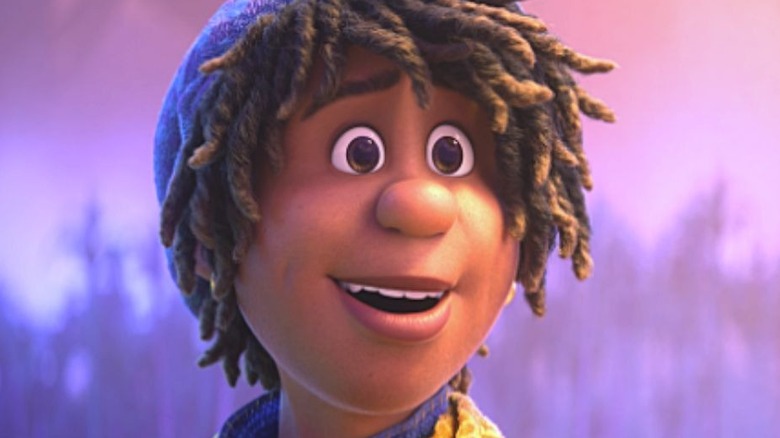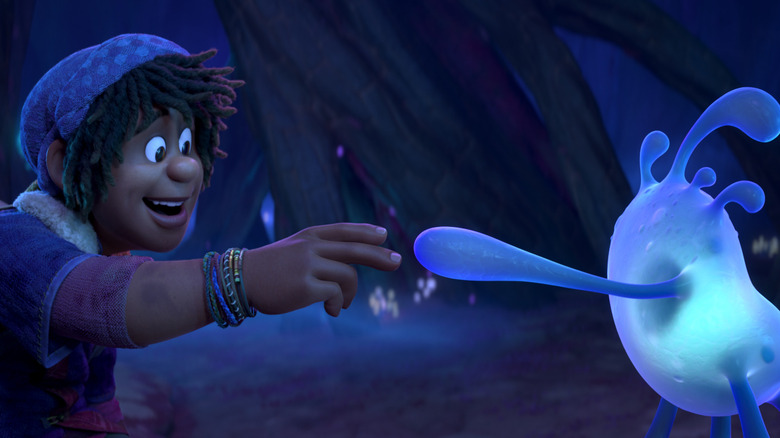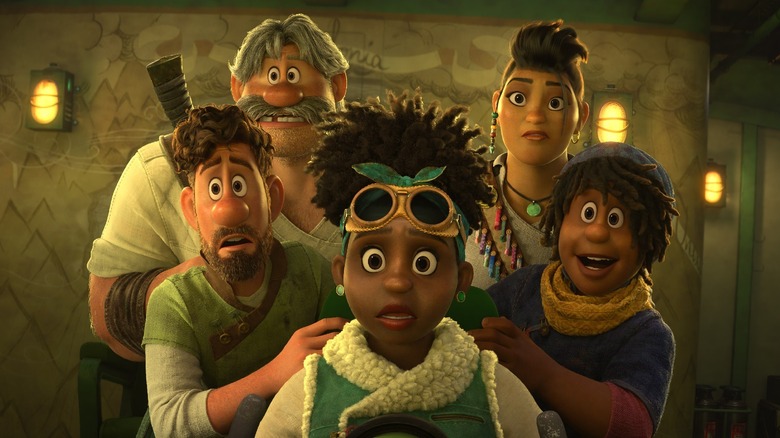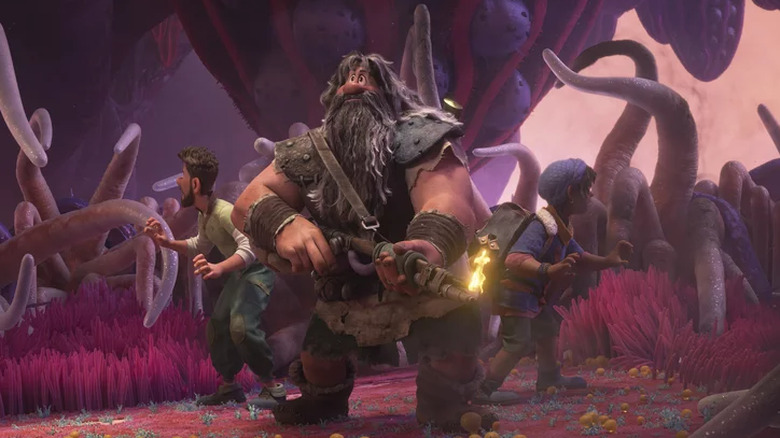Producer Roy Conli On The Ecological Themes Of Strange World - Exclusive Interview
The newest outing from Walt Disney Animation Studios, "Strange World," is set in a beautiful European-esque hamlet called Avalonia. Avalonia's most famous adventurer, Jaeger Clade (Dennis Quaid), has long ago set off to find out what's on the other side of Avalonia's massive, impassable mountain range, leaving his son Searcher (Jake Gyllenhaal) to return with Pando, a mysterious plant that contains energy and revolutionizes Avalonian life.
When there's a problem with Pando (no spoilers here), Searcher, his son Ethan (Jaboukie Young-White), and their family have to go further than anyone in Avalonia have ever gone before. It's a gorgeously animated, vivid world from the seasoned creatives at Disney, and one that's surely going to become a favorite for Disney fans.
In a wide-ranging interview, we spoke with "Strange World" producer Roy Conli about the inventive new outing. We talked about Conli's documentary background, the film's deeper meanings, the collaboration that created these novel ecological worlds, and more.
A story about helping the next generation
You had an interesting history with Disney before pivoting into nature documentaries, but then you come back to create this very ecologically informed and complex narrative. How did your documentary background impact the creation of "Strange World"?
It's interesting, because before I started doing documentaries, which I started actually right after "Big Hero 6," I was invited to come down and help pulling "Born in China" together. I've always been very interested in ecology and [in] social responsibility, in terms of how we treat our planet.
If anything, it was [director] Don [Hall]'s conception of this project. When I came to it and he pitched it to me, I was so impressed with where he had gone in terms of wanting to tell a story about what we leave to our next generation. That's such an incredible and important message right now for the world because I think we do have a responsibility to leave this planet in a better state. If we all thought that way, we could actually help the next generation, and they'll help the next generation, and we'll continue on. It definitely is something that has always been top of mind in my life.
I also appreciate this notion that their world is part of a wider ecosystem, that the characters find out that they are part of an ecological whole. How did you know that you wanted that to be part of the story?
Again, that was very early in Don's conception of this piece. I think Don wanted to make sure that he was telling a story about what his father left him and what he was going to leave to his sons. Within that structure was always an ecological message but also a gift. What is the gift that you pass on? From day one, that was the heart of it. Then combine that with the fact that Don [Hall] and [writer] Qui [Nguyen] and [I] love action-adventure films, and go from that.
We all read Jules Verne and H.G. Wells and Sir Arthur Conan Doyle when we were kids. That's a straight line — those stories into action-adventure films of the 20th century to now. The wonderful thing about Don is he creates these worlds that are absolutely unique and yet are reflective of our world. Avalonia is a mythical land, but it totally reflects our being and our world, and you can only visit it in animation. That's [something] so cool [that] Don does.
Animation is the most collaborative art form
Strange World is such an entirely newly created world. What was the process like for you and the animators creating Avalonia and creating this undiscovered, strange world [that's] a blank check?
The fact that it's a blank check is actually an invitation to create. I was asked earlier, "You worked on 'Treasure Planet' — how did you bring your experience from that film to this film?" Every film is brand new. Every film is brand new, and it's a different group of people, different types of communication.
The one advantage I had is I've worked with Don now on two films and on a Disney+ project. I know the worlds that he wants to create, and the way he works with the team is really open. It's an open-door policy. It's, "Bring me your thoughts, and we will craft this together." When you look at the final images of this film, it is literally 450 people's idea[s] of this world. It's the great thing about animation; it's the most collaborative art form I can think of.
The dynamic between Jaeger, Searcher, and Ethan was really interesting. At face value, Jaeger's is a standard archetypal hero's journey, but the lesson is unbalanced, and then Ethan ends up as a modernized version of that archetype. Tell me about the process of honing and designing those characters, and knowing that's the narrative you want to tell.
It was clear from the very beginning. As we went into this, there is the classic white-shirt hero of pulp magazines. He's always wearing a white shirt going through the jungle. I don't know why.
You can look at it on many different levels. You can look at it as boomer, millennial, and Z in terms of thought progression. You can look at it from [the perspective of] Jaeger is the conqueror. Searcher is the controller because he's a farmer; he wants to control nature. And then Ethan, who is the most compassionate of them all and probably the most enlightened, becomes the conservationist, and he influences the elder generations. Gabrielle Union [who plays Meridian Clade] said this and I love it: It's this wonderful story about three generations learning to understand and fulfill one another's vision of this world and yet still change and grow.
Quiet, eyeless creatures can be 'expressive and amazingly compelling'
Can we talk a little bit about the design of the creatures? I've heard they have some interesting names.
They have very interesting names. First, one of the things that we decided is that we wanted this to be a world that no one has ever seen. And one of the guidelines, as we went into creating the strange world below, was [that] we wanted to take out green, brown, and blue, the three primary colors of our Earth. That was one of the rules.
In terms of Avalonia up high, we wanted to make sure that it was a world unlike any world that we've ever seen. We were using these 19th-, early-20th-century stories by Jules Verne and H.G. Wells and whatnot as an inspiration. But we didn't want steampunk, because steampunk is essentially a dirty, gritty world because they're using coal to boil water that makes steam, [whereas] Pando was essentially a pure force. So creating Avalonia was great.
Then when we got down and started creating the world of creatures below, one of the things that Don said early on is, "I don't want any of them to have faces." It plays right into Don's kind of inspiration from animation, that quiet and eyeless creatures can actually be expressive and amazingly compelling.
There's the Transportasaurus, who transports the Nubbins, which are the little orange balls. There's the Slug Bus, which is the creature that Searcher steps into and starts sinking through, and then they ride to go help Ethan. There are the pterodactyls. The pterodactyls are the flying red creatures that they first meet, which is nodding to a "Lost World" aspect but at the same time a new type of creature.
[For] each one of those creatures, we invited our teams to go and bring back ideas, thoughts, and whatnot. And as they would come in, [they had] influences from the terrestrial world, the aquatic world, the microscopic world. And Don and the team shaped a world in which these creatures had specific duties and how that worked.
It really does feel larger than life, especially on a larger screen.
That's key to this film. I think people have to see it in the theater. Not only do they have to see it in theater, I'm pushing 3D on this one. I'm not a big 3D fan, but the 3D on this film enhances the story. It actually enhances the story. I'm a big, big, big fan of what Anita, our head of 3D stereo, has done. If you haven't had a chance to see it in 3D, see it in 3D, because it's mind-blowing.
"Strange World" premieres on November 23 in theaters.
This interview has been edited for clarity.



